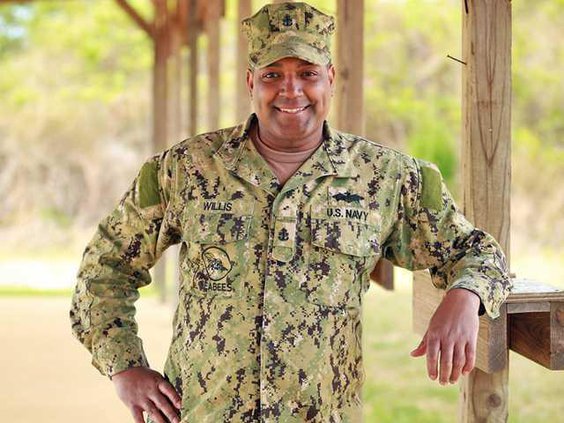Seven years after he graduated from high school, Hinesville native Chief Petty Officer Bernard “Eric” Willis began a career as a Navy Seabee, providing construction and disaster recovery around the world.
Willis said he graduated from Bradwell Institute in 1991 then moved around a lot — to Florida, the Southwest and then Kentucky, where he worked for a lumber company. That job sparked his interest in construction, he said.
Willis said his father moved their family to Hinesville in 1974. Having grown up in an Army town, he admitted he didn’t know much about the Navy, except that someone once told him the Navy has some “really good schools.”
“I went down to the recruiting station to talk with the Navy recruiter,” Willis said, noting he’d already made up his mind he wanted to join the Navy, not the Army, Air Force or Marine Corps. “I was 25 years old, so I had an idea what I wanted to do. I went in and told the recruiter I wanted to work in construction and serve my country.”
In January 1998, Willis enlisted in the Navy with a contract to be trained as a Seabee. Following basic training in Great Lakes, Ill., he graduated top of his class at the 13-week Builder “A” School in Gulfport, Miss. He then was assigned to the Naval Mobile Construction Battalion 74 at Gulfport, he said. During his first tour with NMCB 74, Willis was deployed to Puerto Rico, Korea, Cuba and the Bahamas.
After four years, he was reassigned to Construction Battalion Unit 418 at Submarine Base Bangor, Wash. At that point, he was a petty officer first class, whose duties included serving as a unit project supervisor, command fitness leader and squad leader. He said he was deployed to Spain and Iraq in support of Iraqi Freedom in 2003. By the end of his tour in Falujah, Iraq, Willis had been promoted to chief petty officer, which is equivalent to a sergeant first class in the Army.
“The biggest project we worked on while I was in Iraq was an airfield in Kuwait,” he said. “Seabees fall under the Navy’s deployment cycle, which includes six months at sea for deployments and six month in the home port. We mostly do a lot of training while at home port.”
Willis was transferred in 2006 to the Naval Support Unit in Washington, D.C., then assigned to the U.S. Consulate in Frankfurt, Germany, where he was in charge of 21 Seabees. He reported to the NMCB 18 in Joint Base Lewis-McChord in Washington then back to NMCB 74, both in 2009. He has made two deployments to Japan since that time.
He said major projects Seabees take on include airfields, parking lots and buildings. Seabees specialize in “advance base construction, battle-damage repair, contingency engineering, humanitarian assistance and disaster-recovery support to fleet and unified commanders.” Willis said.
He called Seabees the “premier military engineer units in the world today,” explaining the construction battalions were born out of necessity during World War II. Their 72-year legacy is carried on today by the men and women of the Naval Construction Force who build and fight, Willis said.
The Seabees can build any vertical or horizontal structure that costs less than $750,000 for labor and materials, he said. He emphasized that Seabees do not compete with civilian contractors for major construction projects on stateside military bases.
Willis is married to another Bradwell graduate, the Rachael Willis (née Smith). They have three children, daughter Jordan and sons Tristan and Cameron.
Hinesville native now a Navy Seabee


Sign up for our e-newsletters